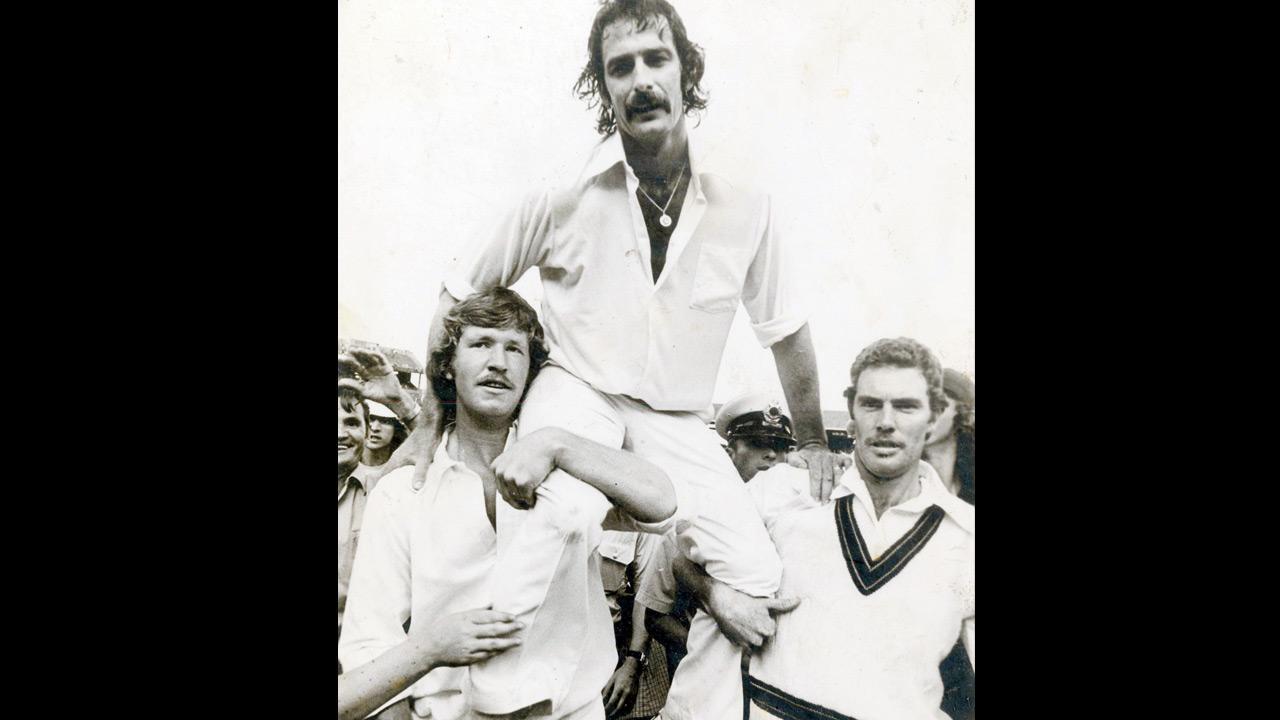Forty-five years ago on this day, Australia beat England by 45 runs to clinch the 1977 Centenary Test by the same margin as they did in the inaugural Test 100 years ago at the same Melbourne Cricket Ground

Australian batsman Gary Cosier (left) and skipper Greg Chappell lift Dennis Lillee (centre) back to the Melbourne Cricket Ground pavilion after the hosts beat England by 45 runs to win the Centenary Test on March 17, 1977. Pic/Mid-day Archives
 The number 45 bodes well for cricket today. Forty-five years ago, to the day, Australia beat England by 45 runs to win the 1977 Centenary Test match at the Melbourne Cricket Ground (MCG), the exact margin of their victory over the old enemy in the first-ever Test match held 100 years ago in March 1877.
The number 45 bodes well for cricket today. Forty-five years ago, to the day, Australia beat England by 45 runs to win the 1977 Centenary Test match at the Melbourne Cricket Ground (MCG), the exact margin of their victory over the old enemy in the first-ever Test match held 100 years ago in March 1877.
ADVERTISEMENT
The Centenary Test made for a thrilling game of cricket, with either side in with a chance to win it on the final day. It had an odd ring to it too. The first two innings saw only 233 runs being scored, but the next two totalled 836!
With every living player from either side invited to witness the Test and the majority of them making it on special flights out of the United Kingdom and the various Australian states, Melbourne was the place to be in for a cricket lover.
And every playing member – from Amiss to Woolmer of England and Chappell to Walters on the Australian team sheet -- wanted to look their best as it were on a stage which could hold nothing less than top quality cricket.
The pre-Test ceremonies involved a parade of Australian and England captains, with 87-year-old Jack Ryder leading the way for the hosts. England had Bob Wyatt, 76, whose side bore the brunt of Don Bradman’s 758 runs in the 1934 series. Tony Greig won the toss and sent Australia in; something that went against convention amongst the most traditional practitioners of the game in the pavilion. But Greig’s decision appeared sound with half the Australian side dismissed for 57 by lunch; all out for 138 just after tea.
Among the batsmen dismissed was opener Rick McCosker, who was hit on the jaw by Bob Willis and the ball deflected on to his stumps. The bandaged New South Welshman came out to bat in the second innings to help the recently-deceased Rod Marsh become the first Australian wicketkeeper to score a Test century against England. There is a bracket on the scoresheet to indicate that McCosker came out to bat at No.10 and 25 (in 85 minutes) is the score etched against his name as Marsh got to his hundred.
That was on Day Four when Chappell set England a 463-run target and gave them 11 hours to get it. Bad light brought an end to the fourth day’s play with England needing another 272 runs for victory, with only Bob Woolmer and future captain Mike Brearley back in the pavilion. Derek Randall and Dennis Amiss had put on an unconquered 78 for the third wicket with Keith Fletcher, Greig and Alan Knott to follow. Amiss had a torrid time against Lillee while Randall used his penchant to chat to himself and others as fuel to carry on.
“He is certainly an interesting character with a great temperament and attitude for Test cricket, and is obviously training for the day when he’s finished playing, as a ball-by-ball commentator for the BBC,” wrote Chappell in the book, The 100th Summer.
The funny side of Randall showed up in the first innings as well when he picked himself from the ground after ducking a Lillee bouncer only to doff his England cap to the pace demon.
There was some splendid sportsmanship too — displayed by Marsh when the wicketkeeper signalled that he had not cleanly taken a faint edge off Randall’s flashing bat despite umpire Tom Brooks raising his finger.
From that ‘escape’ at 161, Randall went on to reach 174 in 446 minutes before Cosier caught him at short leg, while Chappell bowled Amiss for 64 off a ball that kept low. Lillee, who had sent back Brearley and Fletcher, added Knott, Old and Underwood to his tally, with O’Keeffe accounting for Greig and Randall. The England innings ended with Knott being trapped leg before by a rampaging Lillee, who claimed his 11th wicket for the Test. He wasn’t denied much that day, except an autograph by the Queen (she met the teams at tea time on the final day) who politely declined to sign his autograph book.
“Not now,” she is reported to have said to Lillee.
The Centenary Test was a heavyweight contest. England were smarting from their two consecutive (1974-75 and 1975) Ashes loses. And Greig, who assumed the captaincy in 1975, was itching to get back at Australia to such an extent that he looked forward to success in the Centenary Test more than he did for the preceding Test series in India. Some may call these warped priorities, but then they didn’t tag the event The Test of the Century for nothing.
mid-day’s group sports editor Clayton Murzello is a purist with an open stance.
He tweets @ClaytonMurzello. Send your feedback to mailbag@mid-day.com
The views expressed in this column are the individual’s and don’t represent those of the paper.
 Subscribe today by clicking the link and stay updated with the latest news!" Click here!
Subscribe today by clicking the link and stay updated with the latest news!" Click here!








